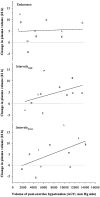Low-Volume Intense Exercise Elicits Post-exercise Hypotension and Subsequent Hypervolemia, Irrespective of Which Limbs Are Exercised
- PMID: 27303310
- PMCID: PMC4885852
- DOI: 10.3389/fphys.2016.00199
Low-Volume Intense Exercise Elicits Post-exercise Hypotension and Subsequent Hypervolemia, Irrespective of Which Limbs Are Exercised
Abstract
Introduction: Exercise reduces arterial and central venous blood pressures during recovery, which contributes to its valuable anti-hypertensive effects and to facilitating hypervolemia. Repeated sprint exercise potently improves metabolic function, but its cardiovascular effects (esp. hematological) are less well-characterized, as are effects of exercising upper versus lower limbs. The purposes of this study were to identify the acute (<24 h) profiles of arterial blood pressure and blood volume for (i) sprint intervals versus endurance exercise, and (ii) sprint intervals using arms versus legs.
Methods: Twelve untrained males completed three cycling exercise trials; 50-min endurance (legs), and 5(*)30-s intervals using legs or arms, in randomized and counterbalanced sequence, at a standardized time of day with at least 8 days between trials. Arterial pressure, hemoglobin concentration and hematocrit were measured before, during and across 22 h after exercise, the first 3 h of which were seated rest.
Results: The post-exercise hypotensive response was larger after leg intervals than endurance (AUC: 7540 ± 3853 vs. 3897 ± 2757 mm Hg·min, p = 0.049, 95% CI: 20 to 6764), whereas exercising different limbs elicited similar hypotension (arms: 6420 ± 3947 mm Hg·min, p = 0.48, CI: -1261 to 3896). In contrast, arterial pressure at 22 h was reduced after endurance but not after leg intervals (-8 ± 8 vs. 0 ± 7 mm Hg, p = 0.04, CI: 7 ± 7) or reliably after arm intervals (-4 ± 8 mm Hg, p = 0.18 vs. leg intervals). Regardless, plasma volume expansion at 22 h was similar between leg intervals and endurance (both +5 ± 5%; CI: -5 to 5%) and between leg and arm intervals (arms: +5 ± 7%, CI: -8 to 5%).
Conclusions: These results emphasize the relative importance of central and/or systemic factors in post-exercise hypotension, and indicate that markedly diverse exercise profiles can induce substantive hypotension and subsequent hypervolemia. At least for endurance exercise, this hypervolemia may not depend on the volume of post-exercise hypotension. Finally, endurance exercise led to reduced blood pressure the following day, but sprint interval exercise did not.
Keywords: HIIT; arm exercise; blood pressure; exercise training; plasma volume; sprint exercise.
Figures

 , continuous heart rate and beat-to-beat blood pressure recordings, M, manual blood pressure measurement;
, continuous heart rate and beat-to-beat blood pressure recordings, M, manual blood pressure measurement;  , blood sample drawn (every 15 min after exercise except at T2:45); and
, blood sample drawn (every 15 min after exercise except at T2:45); and  , standardized meal fed to participants.
, standardized meal fed to participants.




Similar articles
-
Sprint training enhances ionic regulation during intense exercise in men.J Physiol. 1997 Jun 15;501 ( Pt 3)(Pt 3):687-702. doi: 10.1111/j.1469-7793.1997.687bm.x. J Physiol. 1997. PMID: 9218228 Free PMC article.
-
Diurnal effects of prior heat stress exposure on sprint and endurance exercise capacity in the heat.Chronobiol Int. 2018 Jul;35(7):982-995. doi: 10.1080/07420528.2018.1448855. Epub 2018 Mar 21. Chronobiol Int. 2018. PMID: 29561175
-
Similar metabolic response to lower- versus upper-body interval exercise or endurance exercise.Metabolism. 2017 Mar;68:1-10. doi: 10.1016/j.metabol.2016.11.009. Epub 2016 Nov 26. Metabolism. 2017. PMID: 28183441 Clinical Trial.
-
Blood volume: its adaptation to endurance training.Med Sci Sports Exerc. 1991 Dec;23(12):1338-48. Med Sci Sports Exerc. 1991. PMID: 1798375 Review.
-
Transfer effects of endurance training with the arms and legs.Med Sci Sports Exerc. 1991 Sep;23(9):1035-41. Med Sci Sports Exerc. 1991. PMID: 1943623 Review.
Cited by
-
Functional High-Intensity Circuit Training Improves Body Composition, Peak Oxygen Uptake, Strength, and Alters Certain Dimensions of Quality of Life in Overweight Women.Front Physiol. 2017 Apr 3;8:172. doi: 10.3389/fphys.2017.00172. eCollection 2017. Front Physiol. 2017. PMID: 28420999 Free PMC article.
-
Acute and adaptive cardiovascular and metabolic effects of passive heat therapy or high-intensity interval training in patients with severe lower-limb osteoarthritis.Physiol Rep. 2023 Jun;11(11):e15699. doi: 10.14814/phy2.15699. Physiol Rep. 2023. PMID: 37300374 Free PMC article.
-
Cardiac autonomic disturbance following sprint-interval exercise in untrained young males: Does exercise volume matter?J Exerc Sci Fit. 2022 Jan;20(1):32-39. doi: 10.1016/j.jesf.2021.10.002. Epub 2021 Oct 30. J Exerc Sci Fit. 2022. PMID: 34987588 Free PMC article.
-
Acute Effect of Interval vs. Continuous Exercise on Blood Pressure: Systematic Review and Meta-Analysis.Arq Bras Cardiol. 2020 Jul;115(1):5-14. doi: 10.36660/abc.20190107. Epub 2020 Aug 7. Arq Bras Cardiol. 2020. PMID: 32401846 Free PMC article. English, Portuguese.
-
Functional High-Intensity Interval Training Lowers Body Mass and Improves Coordination, Strength, Muscular Endurance, and Aerobic Endurance of Inmates in a German Prison.Front Physiol. 2021 Sep 30;12:733774. doi: 10.3389/fphys.2021.733774. eCollection 2021. Front Physiol. 2021. PMID: 34658918 Free PMC article.
References
-
- Chaplin H., Mollison P. (1952). Correction for plasma trapped in the red cell column of the hematocrit. Blood 7, 1227–1238. - PubMed
LinkOut - more resources
Full Text Sources
Other Literature Sources

